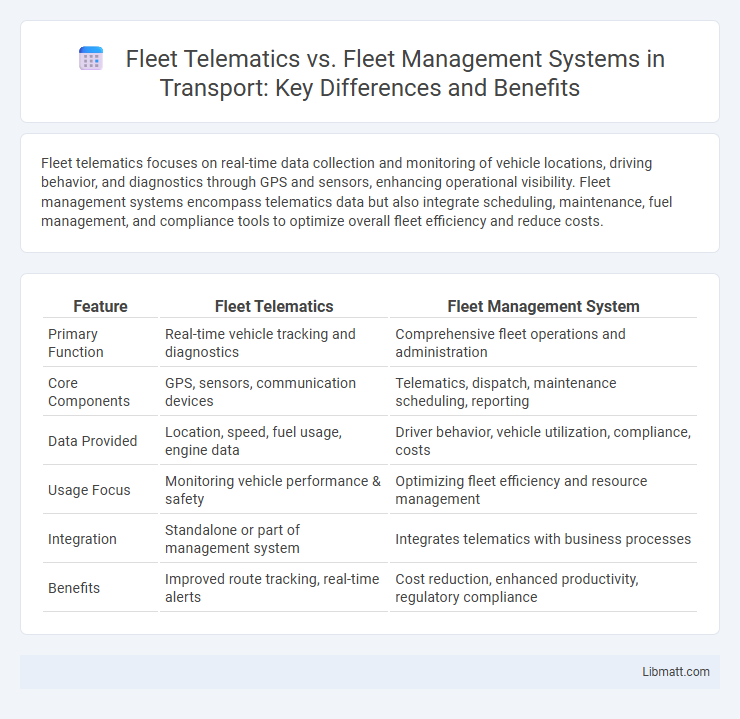Fleet telematics focuses on real-time data collection and monitoring of vehicle locations, driving behavior, and diagnostics through GPS and sensors, enhancing operational visibility. Fleet management systems encompass telematics data but also integrate scheduling, maintenance, fuel management, and compliance tools to optimize overall fleet efficiency and reduce costs.
Table of Comparison
| Feature | Fleet Telematics | Fleet Management System |
|---|---|---|
| Primary Function | Real-time vehicle tracking and diagnostics | Comprehensive fleet operations and administration |
| Core Components | GPS, sensors, communication devices | Telematics, dispatch, maintenance scheduling, reporting |
| Data Provided | Location, speed, fuel usage, engine data | Driver behavior, vehicle utilization, compliance, costs |
| Usage Focus | Monitoring vehicle performance & safety | Optimizing fleet efficiency and resource management |
| Integration | Standalone or part of management system | Integrates telematics with business processes |
| Benefits | Improved route tracking, real-time alerts | Cost reduction, enhanced productivity, regulatory compliance |
Introduction to Fleet Telematics and Fleet Management Systems
Fleet telematics integrates GPS tracking, vehicle diagnostics, and real-time data analytics to optimize fleet performance and reduce operational costs. Fleet management systems combine telematics data with tools for route planning, driver behavior monitoring, and maintenance scheduling to enhance overall fleet efficiency. Understanding the synergy between these technologies allows you to streamline operations, improve safety, and maximize asset utilization.
Defining Fleet Telematics: Key Features and Functions
Fleet telematics integrates GPS tracking, vehicle diagnostics, and real-time data analytics to monitor vehicle location, driver behavior, and engine performance. Key features include route optimization, fuel consumption tracking, and automated maintenance alerts that enhance operational efficiency. Your fleet management system can leverage these telematics functions to improve decision-making and reduce overall fleet costs.
Understanding Fleet Management Systems: Scope and Capabilities
Fleet management systems integrate advanced telematics technology to provide real-time vehicle tracking, driver behavior monitoring, and fuel consumption analysis, enhancing operational efficiency. These systems encompass broader capabilities such as maintenance scheduling, asset utilization, and regulatory compliance, offering a comprehensive approach to fleet optimization. By combining telematics data with management tools, fleet managers can make informed decisions that reduce costs and improve safety.
Core Differences Between Fleet Telematics and Fleet Management Systems
Fleet telematics primarily focuses on the real-time collection and transmission of vehicle data such as GPS location, speed, fuel consumption, and engine diagnostics using embedded sensors and communication technologies. In contrast, fleet management systems encompass a broader scope by integrating telematics data with software tools for route planning, maintenance scheduling, compliance tracking, and driver performance analysis. The core difference lies in telematics serving as the data acquisition layer while fleet management systems provide comprehensive operational control and decision-making support based on that data.
Integration: How Telematics and Fleet Management Work Together
Fleet telematics systems collect real-time data on vehicle location, speed, fuel usage, and driver behavior, providing critical insights for fleet management platforms to optimize operations. Integration of telematics with fleet management systems enables seamless data synchronization, enhancing route planning, maintenance scheduling, and compliance reporting. This unified approach improves efficiency by enabling data-driven decision-making and automating workflow processes across the entire fleet.
Benefits of Fleet Telematics for Modern Fleets
Fleet telematics offers precise GPS tracking, real-time vehicle diagnostics, and driver behavior monitoring that enhance operational efficiency and reduce fuel costs. Integrating telematics enables predictive maintenance, increasing vehicle uptime and minimizing unexpected repairs. These technologies improve safety compliance and streamline route optimization, boosting overall productivity for modern fleets.
Advantages of Implementing Fleet Management Systems
Implementing a fleet management system offers significant advantages over basic fleet telematics by providing comprehensive solutions that include real-time vehicle tracking, maintenance scheduling, and driver behavior analysis. These systems enhance operational efficiency, reduce fuel consumption, and improve overall safety by integrating data from multiple sources into a centralized platform. Your business can achieve cost savings and better decision-making through automated reporting and predictive analytics tailored to fleet performance.
Choosing the Right Solution: Factors to Consider
When choosing between fleet telematics and a fleet management system, prioritize real-time vehicle tracking, driver behavior analysis, and fuel efficiency monitoring to optimize operational performance. Evaluate the integration capabilities, scalability, and data analytics features to ensure seamless communication and actionable insights. Budget constraints and user-friendliness also play crucial roles in selecting a solution that aligns with your specific fleet size and business objectives.
Industry Applications: Real-World Use Cases
Fleet telematics enables real-time vehicle tracking, route optimization, and driver behavior analysis, proving essential in logistics companies for reducing delivery times and fuel consumption. Fleet management systems integrate telematics with maintenance scheduling, compliance tracking, and asset management, widely utilized by public transportation agencies to enhance operational efficiency and safety. Construction firms leverage both technologies to monitor heavy equipment usage, minimize downtime, and ensure regulatory compliance on job sites.
Future Trends in Fleet Telematics and Management Systems
Future trends in fleet telematics and management systems are centered on enhanced AI-driven analytics, real-time data integration, and predictive maintenance capabilities, enabling more efficient and proactive fleet operations. Advances in IoT connectivity and 5G technology will further optimize vehicle tracking, driver behavior monitoring, and fuel management. Your fleet management strategy can greatly benefit from these innovations by reducing operational costs and improving overall safety and compliance.
fleet telematics vs fleet management system Infographic

 libmatt.com
libmatt.com